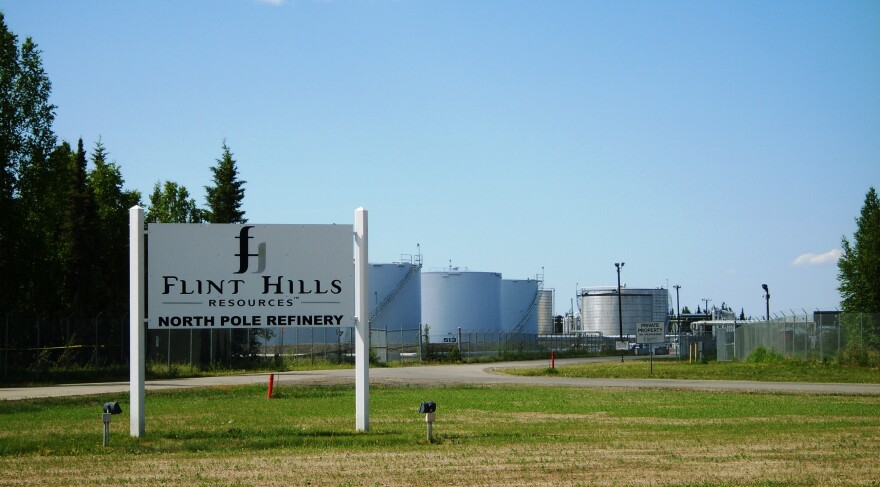North Pole Mayor Bryce Ward says he has some concerns about a proposal by Fairbanks North Star Borough Mayor Luke Hopkins to expand the city’s water system into areas where an industrial solvent has contaminated groundwater. Meanwhile two state environmental officials say they strongly support another proposal by Hopkins to quickly begin cleanup of sulfolane-contaminated groundwater in the North Pole area. But they say the cleanup should wait until the state can complete tests on treating the sulfolane.
North Pole Mayor Bryce Ward says it’s certainly possible to expand the city’s water system into areas where the groundwater has been sulfolane-contaminated. But he’s not sure that the city won’t run into the same problem that it did back when the idea was first proposed, soon after officials with Flint Hills Resources announced in 2009 that sulfolane that had leaked from the refinery had been detected outside the facility’s property.
“The issue at that time was the annexation, and whether or not people wanted to part of the community,” Ward said. “And there was a very strong voice that people did not want to be.”
Ward says the alternative would be for residents of those areas to form a water-service district, then build a system using money raised through service-area fees. He says it’s possible that such a system could be connected to North Pole’s. But he sees the potential for problems with that arrangement, and would prefer that residents of areas outside of town agree to annexation.
“That part of the community would have to become part of the city of North Pole in order for us to service them with our utility,” he said.
The mayor says it’s up to the people to decide which alternative they’d prefer.
“It ultimately is the will of the people. They’d have to decide what they would want,” he said. “And if people are comfortable with the set-up they have now, I think that’s a viable option, too. I mean, y’know, it just depends on what the community wants.”
Ward questions whether either alternative is necessary, because he says there’s already a solution in place – the offer by Flint Hills to provide water to residents in sulfolane-affected areas, if either.

“Everyone (who) wants clean water has clean water, from my understanding,” he said. “And, I think that – again, my understanding of what Flint Hills has done, they’ve done a great job at that.”
Joyce Bonfoey is one of those who’s accepted Flint Hills’ offer. Bonfoey lives off Badger Road outside of city limits, and she says the company set up an alternate supply in 2011 after sulfolane showed up in a sample from her well.
“I do have sulfolane,” she said, “and so I opted to get the underground water tank.”
Bonfoey is a retired nurse who says she showed up Tuesday at an open house meeting in North Pole set up by the Alaska Department of Environmental Conservation because she wants to find out more about the human health effects of sulfolane.
“Because they don’t know -- nobody knows – the effect of it,” she said.
Not much is known about how sulfolane affects humans. Tests in recent years have shown it harms animals that’ve been exposed to high levels of the chemical. But those tests are limited in scope and duration.
The state DEC is working with researchers that are continuing such testing, and the agency is getting assistance from experts with the federal Environmental Protection Agency.
The lack of knowledge about sulfolane has created an obstacle to moving ahead with borough Mayor Luke Hopkins’ other recent proposal on dealing with the groundwater contamination – that is, to begin treating it right away with a technique that’s shown great promise in limited tests at the North Pole refinery – a technique known as “air-sparging,” which involves injecting oxygen into the groundwater to help break down the sulfolane.
Tamara Cardona, the DEC’s sulfolane-contamination cleanup project manager, says agency officials want to ensure that once the sulfolane is broken down, it won’t create other chemical compounds that also may constitute a health threat.
“We would like an answer on whether or not we would be creating any other intermediate products that could be a concern,” she said.
Cardona says she hopes to have answers to that question within a year or so. If tests show there’s no reason for concern, she says the agency could give the go-ahead to begin treating the sulfolane with air-sparging at that time.
The agency would like to begin work treating the contamination sooner, says Ann Farris, another local DEC official who preceded Cardona as project manager and she now works as a special assistant on the issue.
Farris says agency officials agree with Hopkins on the need to both begin treating the contamination and providing an alternative source of water through a municipal water system.
“We do support Mayor Hopkins’ concept of getting cleanup as fast as we can. We absolutely support that,” she said. “We also support the idea of a public water supply. That seems like a long-term solution that could be good for everyone.”
Editor's note: This story was updated on June 28, 2013 to include the full text and photos.



